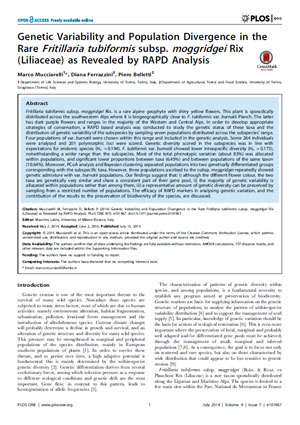NEWS 2014
Genetic Variability and Population Divergence in the Rare Fritillaria tubiformis subsp. moggridgei Rix (Liliaceae) as Revealed by RAPD Analysis
Marco MUCCIARELLI¹, Diana FERAZZINI², Piero BELLETTI²
PLoS ONE 9(7) (2014)
doi: 10.1371/journal.pone.0101967
¹Department of Life Sciences and Systems Biology, University of Torino, Torino, Italy,
²Department of Agricultural, Forest and Food Science, University of Torino, Grugliasco (Torino), Italy
Abstract
Fritillaria tubiformis subsp. moggridgei Rix. is a rare alpine geophyte with shiny yellow flowers. This plant is sporadically distributed across the southwestern Alps where it is biogeographically close to F. tubiformis var. burnatii Planch. The latter has dark purple flowers and ranges in the majority of the Western and Central Alps. In order to develop appropriate strategies of conservation, a RAPD based analysis was conducted to study the genetic status of these taxa and the distribution of genetic variability of the subspecies by sampling seven populations distributed across the subspecies' range. Four populations of var. burnatii were chosen within this range and included in the genetic analysis. Some 264 individuals were analysed and 201 polymorphic loci were scored. Genetic diversity scored in the subspecies was in line with expectations for endemic species (He = 0.194). F. tubiformis var. burnatii showed lower intraspecific diversity (He = 0.173), notwithstanding a wider range than the subspecies. Most of the total phenotypic variation (about 83%) was allocated within populations, and significant lower proportions between taxa (6.45%) and between populations of the same taxon (10.64%). Moreover, PCoA analysis and Bayesian clustering separated populations into two genetically differentiated groups corresponding with the subspecific taxa. However, three populations ascribed to the subsp. moggridgei repeatedly showed genetic admixture with var. burnatii populations. Our findings suggest that: i) although the different flower colour, the two taxa are genetically very similar and share a consistent part of their gene pool, ii) the majority of genetic variability is allocated within populations rather than among them, iii) a representative amount of genetic diversity can be preserved by sampling from a restricted number of populations. The efficacy of RAPD markers in analysing genetic variation, and the contribution of the results to the preservation of biodiversity of the species, are discussed.

